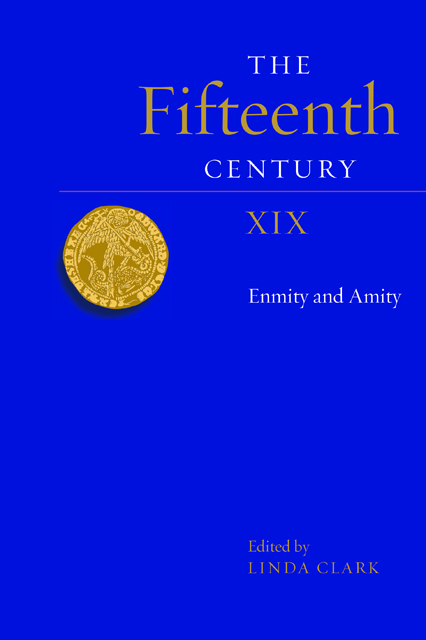Book contents
- Frontmatter
- Contents
- List of Contributors
- Preface
- List of Abbreviations
- England and Europe, c.1450–1520: Nostalgia or New Opportunities?
- Mariners and Marauders: A Case Study of Fowey during the Hundred Years’ War, c.1400–c.1453
- Henry V’s Army of 1417
- ‘Get out of our land, Englishmen’. French Reactions to the English Invasion of 1512–13
- Encountering the ‘Duche’ in Margery Kempe’s Lynn
- ‘C’est le Beaulté de Castille et d’Espaigne, qui le Soleil cler d’Austrice accompaigne’: Jean Molinet makes the Habsburgs Burgundian
- Magna Carta in the Late Middle Ages, c.1320–c.1520
- The Business of the Southern Convocation in 1462
- Index
- Contents of Previous Volumes
Henry V’s Army of 1417
Published online by Cambridge University Press: 20 December 2022
- Frontmatter
- Contents
- List of Contributors
- Preface
- List of Abbreviations
- England and Europe, c.1450–1520: Nostalgia or New Opportunities?
- Mariners and Marauders: A Case Study of Fowey during the Hundred Years’ War, c.1400–c.1453
- Henry V’s Army of 1417
- ‘Get out of our land, Englishmen’. French Reactions to the English Invasion of 1512–13
- Encountering the ‘Duche’ in Margery Kempe’s Lynn
- ‘C’est le Beaulté de Castille et d’Espaigne, qui le Soleil cler d’Austrice accompaigne’: Jean Molinet makes the Habsburgs Burgundian
- Magna Carta in the Late Middle Ages, c.1320–c.1520
- The Business of the Southern Convocation in 1462
- Index
- Contents of Previous Volumes
Summary
At the beginning of Act V of Shakespeare’s King Henry V, Chorus invites his audience to ‘brook abridgement’, in other words to tolerate omission of ‘all the occurrences, whatever chanced’ between the victory at Agincourt on 25 October 1415 and the agreement of the treaty of Troyes on 21 May 1420. Much is indeed omitted. Save for a passing reference by Chorus to the visit to England of the Emperor Sigismund which took place in the spring of 1416, there is no mention at all in the play of events between 1416 and 1419. Yet for the English and their king these years witnessed further substantial achievements in France. In the summer of 1416, an army of at least 7,300 men was raised which was initially intended to be led to France by the king in person but was re-directed, successfully, under the duke of Bedford, to end the French naval blockade of Harfleur. In the summer of 1417 an even larger army was recruited, with which Henry invaded Normandy with conquest his intention. By the summer of 1419 virtually all of the duchy was in his hands, allowing him to begin an advance towards Paris. Instead of the French uniting to resist him, their internal divisions intensified, culminating on 10 September 1419 in the assassination of John the Fearless, duke of Burgundy, by the supporters of the Armagnac faction led by the Dauphin Charles. Nine months later Henry was recognised as heir to the French throne.
The road from Agincourt to Troyes was undoubtedly less direct than Shakespeare implied. While the victory made the French reluctant to face the English in battle again, it was Henry’s systematic conquest of Normandy which gave the French little choice but to negotiate both before and after Duke John’s assassination. It is important, therefore, to examine more closely the army with which Henry invaded in 1417. While this army has not been completely ignored by historians in the past, research linked to the project ‘The Soldier in Later Medieval England’ makes it possible to study the organisation, structure and personnel of the army in much greater depth.
- Type
- Chapter
- Information
- The Fifteenth Century XIXEnmity and Amity, pp. 35 - 67Publisher: Boydell & BrewerPrint publication year: 2022



